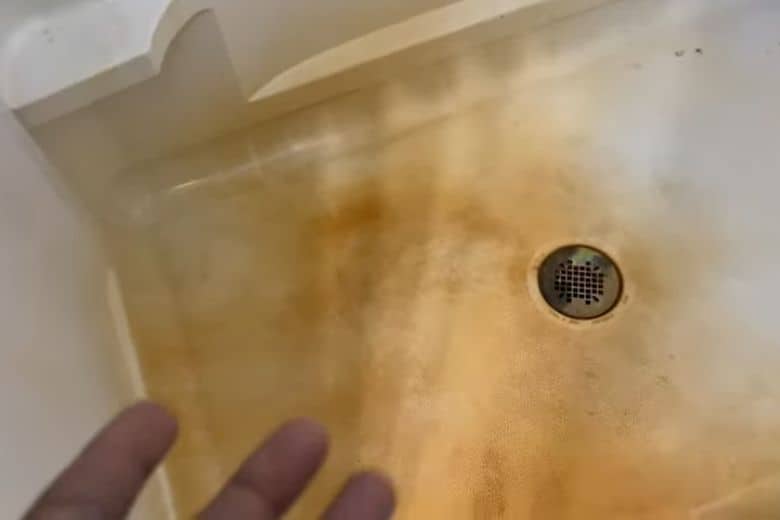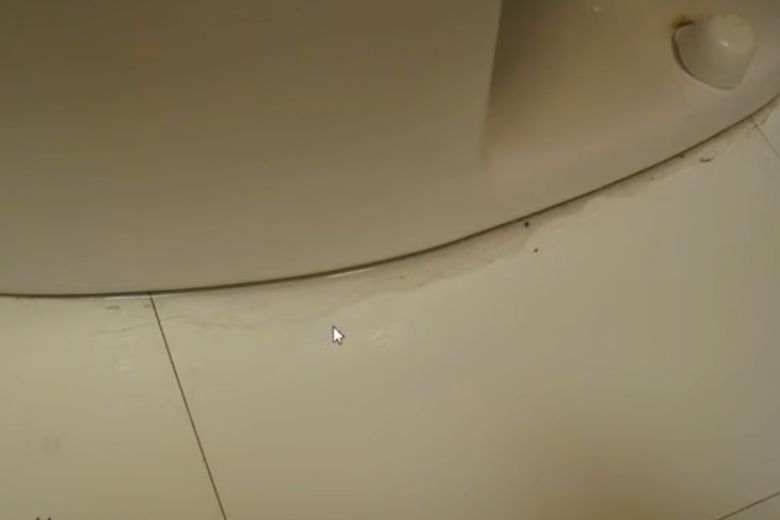Yellow satin in the shower or bathroom sink is a very common issue maximum people face in their day-to-day life. Although it is unsightly and annoying to deal with. But you must encounter it as you have no option left.
However, you might know the primary culprits behind these stains are hard water minerals, soap scum, mold, and mildew. As Hard water contains high levels of minerals such as calcium and magnesium. It can leave behind residue and create yellowish stains over time. Soap scum, on the other hand, forms when soap combines with minerals in the water, further contributing to discoloration.
Apart from these, a few other reasons cause yellow satin in the shower. No matter the reason, you must focus on how to get rid of yellow stains in shower.
Let’s dive in!
What Causes Yellow Stains in Showers
Yellow stains can appear on various surfaces in the shower, including tiles, grout, and glass. These stains can vary in appearance and composition, depending on the underlying cause. By identifying the specific cause, you can choose the most suitable cleaning method and achieve optimal results.
Now, let’s explore the causes behind these yellow stains.
1. Hard Water Deposits
One of the primary culprits behind yellow stains is hard water. Hard water contains a high concentration of minerals like calcium and magnesium. These minerals can leave behind deposits on surfaces, leading to the formation of yellow stains over time.
When hard water is used for bathing, its minerals can react with soap and other cleaning agents, leaving behind a residue. Over time, this residue accumulates and forms yellowish stains on the bathtub surface.
2. Soap Scum Buildup
Soap scum is another leading cause of yellow stains in showers. Soap scum is a filmy residue that forms when soap combines with minerals and oils present in water. It can accumulate on the bathtub surface and contribute to the formation of yellow stains.
As soap scum builds up over time, it can trap dirt, skin cells, and other particles, forming a layer on the bathtub’s surface. This layer can gradually turn yellow and become difficult to remove.
3. Mold and Mildew Growth
Mold and mildew are types of fungi that thrive in moist environments. They can grow on the bathtub surface, especially in areas with poor ventilation or excessive moisture.
The mold and mildew can also lead to yellow stains in the shower. These fungi thrive in damp environments and can cause stains and health issues. The yellow discoloration often accompanies the black or greenish patches typically associated with mold and mildew.
Moreover, mold and mildew stains can be particularly stubborn and require targeted cleaning methods.
4. Rust and Iron Deposits
Rust and iron stains appear as reddish-brown or yellowish discolorations on the bathtub surface. These stains can occur if the water supply contains high levels of iron. On the other hand, if the bathtub fixtures are made of materials prone to rusting.
Iron or rust particles can oxidize and leave unsightly stains on the bathtub when they meet water. These stains can be challenging to remove and may require specific cleaning methods.
5. Chemical Reactions
Certain cleaning products or chemicals can irritate the bathtub surface, causing discoloration and yellow stains. Harsh chemicals, including bleach and abrasive cleaners, can strip the tub’s finish, leaving it vulnerable to staining.
6. Neglected or Poorly Maintained Bathtubs
A neglected or poorly maintained bathtub is more susceptible to yellow stains. Regular cleaning, proper maintenance, and prompt addressing of underlying issues can help prevent these stains’ formation.
How to Get Rid of Yellow Stains in Shower: Tried and Tested Methods
There are multiple methods available to clean the satin mark from your shower. We have described 3 different remedies, including home remedies. Let’s explore which one fits your need.
Natural Remedies for Removing Yellow Stains
If yellow stains have already appeared in your shower, fret not! Several natural remedies can effectively eliminate these stains without harsh chemicals. These remedies are often readily available in most households. Have a look.
1. Lemon Juice
Lemon juice is a natural acid that can break down hard water deposits and dissolve soap scum. Squeeze fresh lemon juice onto the stained areas and let it sit for a few minutes. Scrub the stains gently with a sponge or brush, then rinse thoroughly. The citric acid in lemon juice acts as a natural bleach. It restores the whiteness of the affected surfaces.
2. Apply White Vinegar
White vinegar is another excellent natural remedy for yellow stains. Its acidic properties make it effective in removing mineral deposits and soap scum. Mix equal white vinegar and water in a spray bottle. Now spray the solution onto the stains. Allow it to sit for a few minutes before scrubbing and rinsing. Vinegar not only removes stains but also helps eliminate any lingering odors.
3. Baking Soda Remedy
Baking soda is a versatile cleaning agent that can tackle stubborn yellow stains. Make a paste by mixing baking soda with a small amount of water. Apply the paste to the stains and let it sit for some time. Scrub the stained areas gently, then rinse thoroughly. Baking soda is a mild abrasive. It can help lift stains without damaging the surfaces.
Commercial Cleaners for Stubborn Stains
While natural remedies are effective for many yellow stains. But some stubborn ones may require the use of commercial cleaners. These cleaners are specifically formulated to tackle tough stains and can provide more immediate results.
1. Bleach-based Cleaners
Bleach-based cleaners are highly effective in removing yellow stains caused by mold or mildew. They contain chlorine bleach. It has powerful disinfectant and stain-removing properties. Follow the instructions on the cleaner’s packaging carefully. As bleach can be harsh and may require proper ventilation during application.
2. Oxygen-based Cleaners
Oxygen-based cleaners are an excellent alternative to bleach-based products. They use hydrogen peroxide as the active ingredient. It can break down stains and eliminates odor-causing bacteria. These cleaners are often gentler on surfaces and safer in enclosed spaces.
3. Lime and Rust Removers
For yellow stains caused by hard water deposits, lime and rust removers can be highly effective. These cleaners are specifically formulated to dissolve mineral deposits. Therefore, can restore the original appearance of surfaces. Follow the manufacturer’s instructions and take necessary precautions. Such as wearing gloves and proper ventilation, when using these products.
Cleaning Techniques for Yellow Stains
While the choice of cleaning agent is essential. On the contrary proper cleaning, techniques are equally important to ensure effective stain removal.
1. Surface Preparation
Before cleaning, remove any loose debris or dirt from the stained surfaces. This can be done by rinsing the shower area. Apply warm water or use a gentle brush to dislodge loose particles.
2. Application of Cleaning Solutions
Apply the chosen cleaning solution to the yellow stains, ensuring complete coverage. Allow the solution to penetrate the stains for the recommended duration. As mentioned in the product’s instructions or based on the chosen natural remedy.
3. Scrubbing and Rinsing
Using a sponge, brush, or scrub pad, gently scrub the stained areas in a circular motion. Pay extra attention to the corners and grout lines. Rinse the surfaces thoroughly with water to remove any residue or cleaning solution.
Preventive Measures to Maintain a Stain-Free Shower
While it’s important to know how to remove yellow stains, preventing them in the first place is equally crucial. By following these preventive measures, you can minimize the occurrence of yellow stains and keep your shower looking pristine.
1. Regular Cleaning Routine
Establishing a regular cleaning routine for your shower is key to preventing yellow stains. Clean the surfaces at least once a week. Use a mild bathroom cleaner or a mixture of vinegar and water. Regular cleaning will help remove buildup before it turns into stubborn stains.
2. Squeegee after Showering
After each shower, use a squeegee to remove excess water from the walls and floor of your shower. This simple step will prevent water from pooling. Therefore, minimize the accumulation of mineral deposits and soap scum.
3. Proper Ventilation
Proper ventilation is essential to combat mold and mildew growth, which can contribute to yellow stains. Ensure your bathroom is well-ventilated. You can use exhaust fans or open windows during and after showering. It will help reduce the humidity and moisture levels. Besides making, it is less favorable for mold and mildew to thrive.
Frequently Asked Questions
Are natural remedies as effective as commercial cleaners?
Answer: Natural remedies can be highly effective for many yellow stains, especially those caused by hard water deposits or soap scum. However, commercial cleaners specifically formulated for stain removal may provide quicker and more immediate results for stubborn stains.
Can I prevent yellow stains by using shower curtains or liners?
Answer: Using shower curtains or liners can help prevent water splashes and reduce the chances of yellow stains. In that case, you need to ensure they are regularly cleaned and dried to prevent mold or mildew growth.
What should I do if the yellow stains in my shower persist despite cleaning?
Answer: If the yellow stains persist despite regular cleaning, it may be necessary to seek professional help. A professional cleaner or plumber can assess the situation. They can provide targeted solutions to eliminate stubborn stains effectively.
Conclusion
Yellow stains in the shower can be stubborn and challenging to eliminate. But with the right techniques and preventive measures, you can restore the cleanliness of your bathroom. Remember to tackle the stains promptly using natural cleaning agents like vinegar, lemon juice, and hydrogen peroxide. Additionally, implement preventive measures such as regular cleaning, and squeegeeing after showering. Lastly, maintain proper ventilation to keep yellow stains at bay.
Paul Newman is a blogger who writes about plumbing and home improvement. Over the past 20 years, I have worked as a plumber. My passion is to share my knowledge and experience with others to improve their homes.




